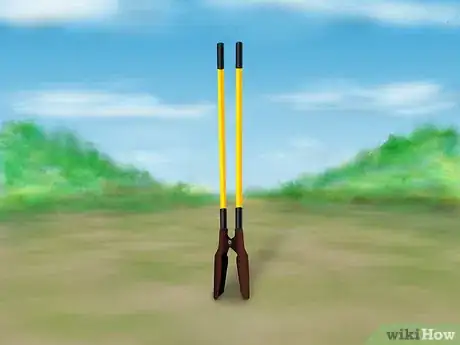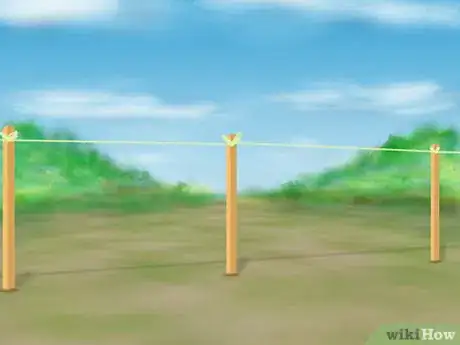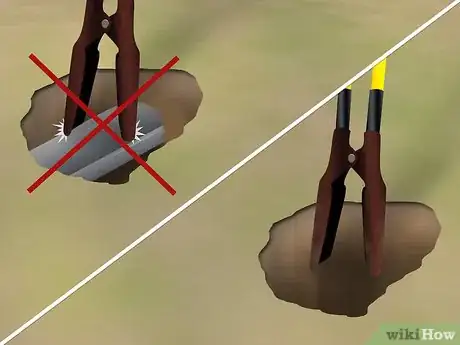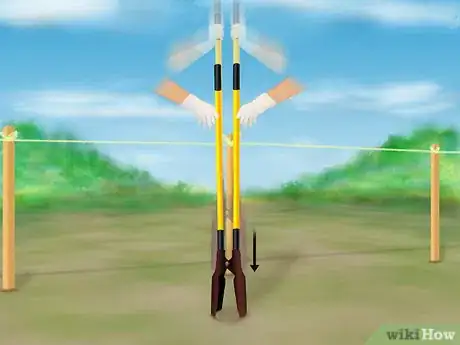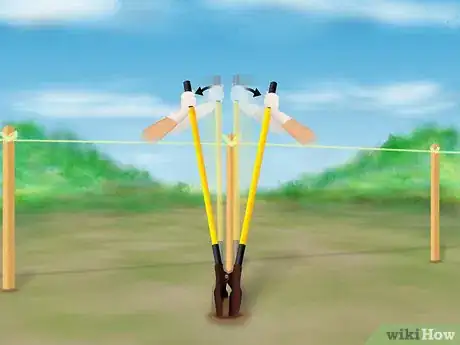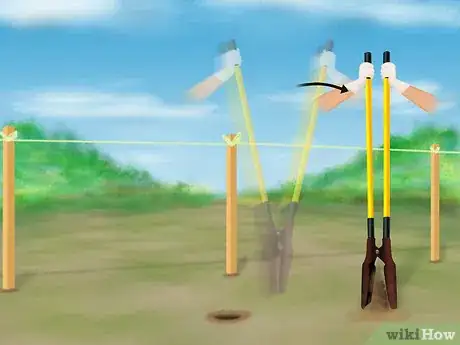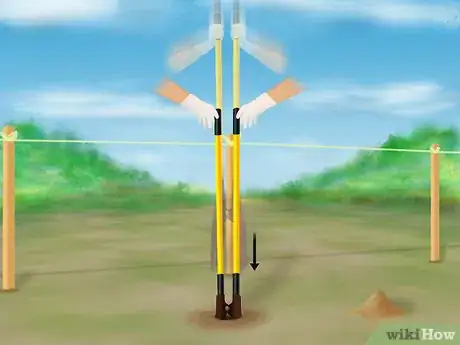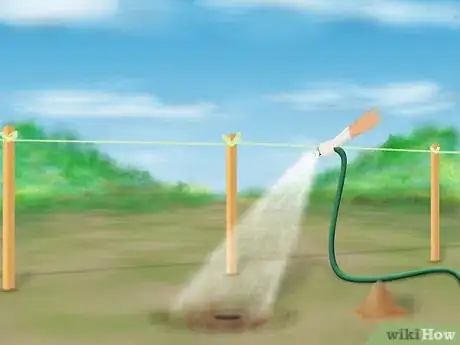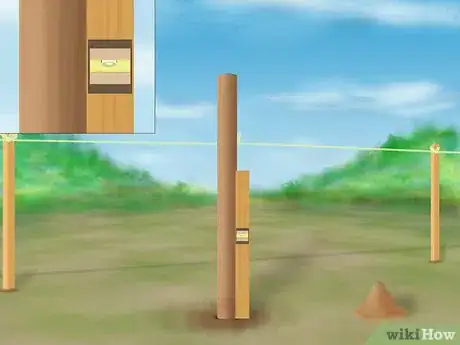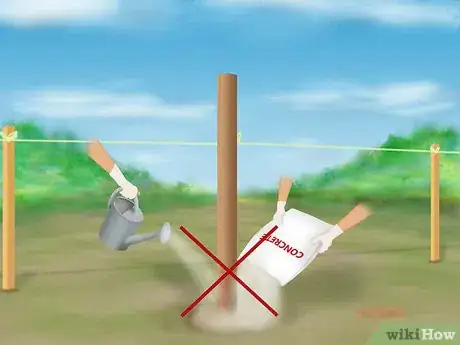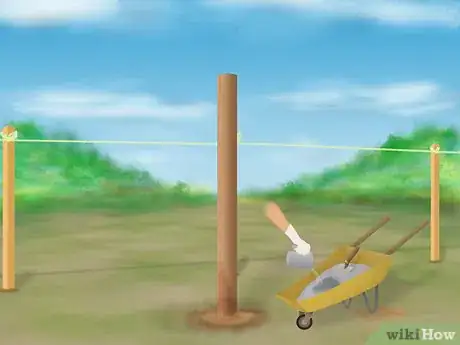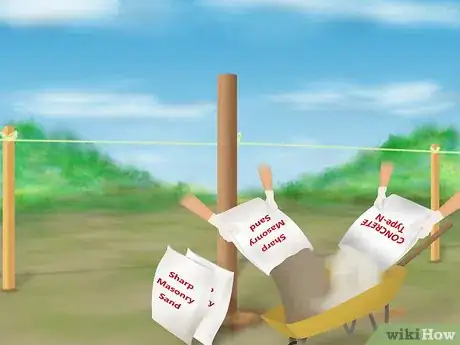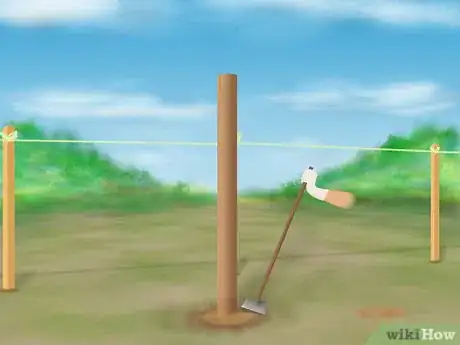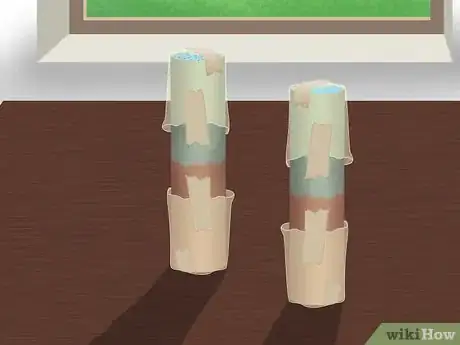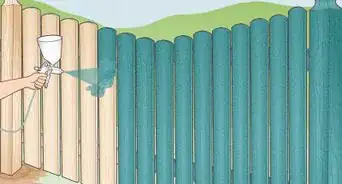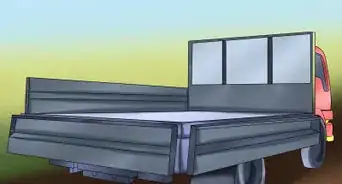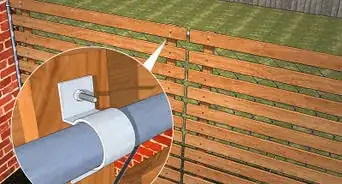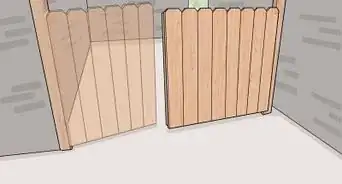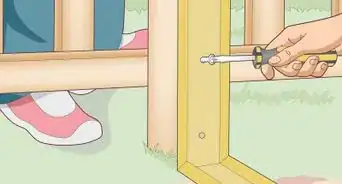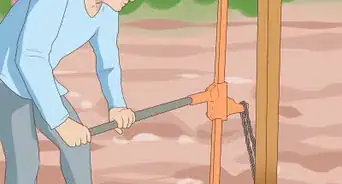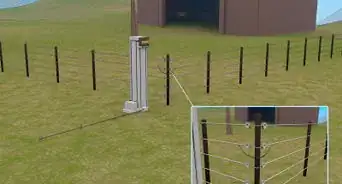This article was co-authored by Anthony "TC" Williams. Anthony "TC" Williams is a Professional Landscaper in Idaho. He is the President and Founder of Aqua Conservation Landscape & Irrigation, an Idaho Registered Landscape Business Entity. With over 21 years of landscaping experience, TC has worked on projects such as the Idaho Botanical Garden in Boise, Idaho. He is a Idaho Registered Contractor and a previously Licensed Irrigator in the State of Texas.
This article has been viewed 537,582 times.
Whether you are building a fence or putting up a flagpole or a bird house on a pole, you may find the need to dig a small diameter hole. Using a shovel for this job means making your hole larger than you need, so you may choose to use post hole diggers for the job instead. Here is how it is done.
Steps
Preparing to Dig
-
1Obtain a pair of post hole diggers. This tool is designed specifically for the task, and will enable you to do the job in the least time with minimum effort. There are a few things you need to consider, however, before starting.[1]
- Check the soil consistency.
- Rocky soils are difficult to use post hole diggers in, since a relatively small stone will prevent the cutting edge of the diggers from penetrating the soil. You can use a steel rock bar to loosen the rocks before using the post hole digger.
- Very loose, sandy, and dry soils, or otherwise stubborn ground, are hard to remove from the hole, as the clamping action of the jaws is not as effective on these non-cohesive materials. If you have time, start the holes one day, fill them with water and come back to remove the much softened soil the next day.
- Measure and mark the location of each fence post.
- Post hole diggers have a maximum effective depth of about 3/4 of their handle length, so a five foot pair will dig about 3 1/2 half deep.
- Very hard earth like clay is extremely difficult to dig with a manual pair of post hole diggers. A rock bar may work on dry clay.
-
2Select the location for the hole you will dig. If it is a single hole for a project like installing a flagpole, you can eyeball the location, but for fences and other projects requiring multiple holes, you may want to lay out the locations of you holes more accurately. Using stakes and a string line to guide you, and a long measuring tape to establish your spacing will help for this purpose. Plant the stakes on either end of the line that you want to dig along. Tie the string to one stake, pull taut, and tie to the other stake.[2]
- The average spacing for posts is eight feet (2.4 m), though depending upon the structure you could space them further apart.
Advertisement -
3Determine if there is any possibility of underground utilities being in the area you are digging. For fencing around a field on private property, this may not be an issue, since the property owner should be aware of any utility right of ways on his land, but if there is any doubt, call your local utility locating service to be sure.[3]
- Be sure to call your local utilities at least three days prior to digging to have your utility lines located. Depending upon your location, it may be illegal to begin digging without requesting a utility survey.
Digging the Post Holes
-
1Begin digging by holding the post hole diggers by the handles, one in each hand, with the handles close together. Thrust the blades into the earth so they cut a plug out of the soil (and turf, if there is any present).[4]
- If the soil or turf resists the digger's blade, you may repeat the downward thrust several times to cut into the soil and break it up. Rotate the diggers when in the ground for better results.
- You should penetrate the soil several inches before extracting the soil (dirt) you are removing.
-
2Spread the handles apart to capture the soil in the jaws (between the hole digger's blades), using enough pressure to grasp it securely, then lift the hole diggers out of the hole.[5]
-
3Swing the hole diggers to the side of your hole, then close the handles back together. This will open the jaws and allow the soil you have extracted to spill out.[6]
-
4Repeat the steps above, going deeper with each successive thrust. If roots or other difficult material interfere with your progress, rotate the blades so you attack the obstacle from a different angle until they are cut through. Start narrow and make the hole wider as you go deeper. This will help stabilize the post. Moist soil will hold better than dry soil[7]
-
5Wet the soil if you encounter very hard material or very sandy, dry material you cannot otherwise extract with a reasonable effort. Allowing the soil to soak up moisture will improve your success and make the job easier.[8]
Installing Your Posts
-
1Install your posts.'" Install the posts, pole, or other item for which you have dug your hole. Use fine gravel tamped down to the bottom six inches (15 cm) and set your post. Plumb the post and install cross bracing on opposite sides to hold the plumb.[9]
- Plumb it up with a builder's spirit level if desired backfill the hole, and tamp the fill material to stabilize it.
-
2When using concrete to set the fence posts in place be sure to use proper concrete working techniques to avoid weak fence post anchors.[10]
- Some contractors prefer to dump dry pre-bagged concrete into the hole and sprinkle with water. This would decrease the finished strength of the concrete by as much as 80% as you can not control even mixing or water proportions.
-
3Use the minimal amount of water to mix concrete for maximum strength. A damp sand feel to the concrete is enough to complete the chemical reaction to make the concrete hard. Adding more water can help to make the concrete easier to place but will dramatically reduce the finished strength.
-
4For large projects it is more cost effective to make your own concrete mix as opposed to using bagged concrete. Use 3 parts sharp masonry sand to 1 part type 1 (or type N) concrete for a strong mortar mix or add 2 parts gravel to bulk up each mix.
- If you are setting a number of posts, consider renting a portable mixer.
-
5How deep to dig the hole? There is only one hard-and-fast rule when you're digging a fence posthole: Dig a hole for the post that is half as deep as the fence is high.
-
6Why use concrete? Concrete makes a wooden post rot faster. The wood will rot sooner or later and you will have to dig out the concrete when you replace the post. Instead put a rock/slate into the hole for the post to rest on and fill around it with rocks/gravel and finally sand which you can pound down to keep the post straight.
Community Q&A
-
QuestionI want to dig a hole 18 feet deep and 4 feet in diameter. What is the quickest way to do that?
 Community AnswerGet an excavator. The cave-in protectors that keep people from getting buried alive only are about 8' deep or so. An excavator is both faster and much safer for the depth you're after.
Community AnswerGet an excavator. The cave-in protectors that keep people from getting buried alive only are about 8' deep or so. An excavator is both faster and much safer for the depth you're after. -
QuestionThe hole for my 8 foot fence post is 3 feet deep. Do I fill it with concrete up to ground level?
 Community AnswerNo. You should fill it up to a point just below ground level and cover it with earth. Ideally also make sure the top of the concrete slopes away from the post so water doesn't pool against the wood.
Community AnswerNo. You should fill it up to a point just below ground level and cover it with earth. Ideally also make sure the top of the concrete slopes away from the post so water doesn't pool against the wood. -
QuestionWhat if I have a pole in the ground, can I use the same hole for the same type of pole?
 Community AnswerIf there's a pole in the hole you won't be able to fit another pole in that hole. Take out the old pole and put a new pole in. And recement.
Community AnswerIf there's a pole in the hole you won't be able to fit another pole in that hole. Take out the old pole and put a new pole in. And recement.
Warnings
- Call to have underground utilities located before digging.⧼thumbs_response⧽
- Using post hole diggers can be strenuous work, wearing gloves will help prevent blisters, but do not over-exert yourself on your task.⧼thumbs_response⧽
Things You'll Need
- Post hole diggers
- String line
- Spirit level
- Measuring tape
- Shovel for back filling your hole
References
- ↑ https://www.familyhandyman.com/garden-structures/fences/how-to-dig-a-hole-pro-tips/view-all#step1
- ↑ https://www.lowes.com/projects/gardening-and-outdoor/lay-out-and-dig-a-post-hole/project
- ↑ http://call811.com/
- ↑ https://www.thisoldhouse.com/how-to/how-to-use-post-hole-digger
- ↑ https://www.thisoldhouse.com/how-to/how-to-use-post-hole-digger
- ↑ https://www.thisoldhouse.com/how-to/how-to-use-post-hole-digger
- ↑ https://www.thisoldhouse.com/how-to/how-to-use-post-hole-digger
- ↑ https://www.familyhandyman.com/garden-structures/fences/how-to-dig-a-hole-pro-tips/view-all#step1
- ↑ https://www.familyhandyman.com/garden-structures/fences/how-to-set-fence-posts-that-won-t-rot/view-all
About This Article
To dig post holes with post hole diggers, start by holding one handle in each hand with the handles close together. Then, thrust the blades into the ground where you want to dig your first hole. Once the blades are in the ground, spread the handles apart so the jaws of your post hole diggers close around the dirt. When you can’t spread the handles any further, lift the post hole diggers out of the ground. Move them away from your hole and close the handles to release the dirt you just collected. If you need the hole to be deeper, rotate the handles to a different angle and repeat the process in the hole. For more tips from our Landscaping co-author, including how to avoid plumbing and wires when digging post holes, read on!
